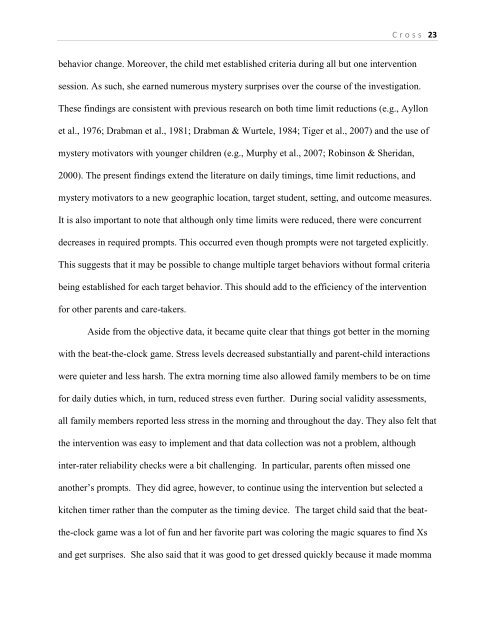THE EFFECTS OF A TIMER AND MYSTERY MOTIVATORS ON THE ...
THE EFFECTS OF A TIMER AND MYSTERY MOTIVATORS ON THE ...
THE EFFECTS OF A TIMER AND MYSTERY MOTIVATORS ON THE ...
Create successful ePaper yourself
Turn your PDF publications into a flip-book with our unique Google optimized e-Paper software.
C r o s s 23<br />
behavior change. Moreover, the child met established criteria during all but one intervention<br />
session. As such, she earned numerous mystery surprises over the course of the investigation.<br />
These findings are consistent with previous research on both time limit reductions (e.g., Ayllon<br />
et al., 1976; Drabman et al., 1981; Drabman & Wurtele, 1984; Tiger et al., 2007) and the use of<br />
mystery motivators with younger children (e.g., Murphy et al., 2007; Robinson & Sheridan,<br />
2000). The present findings extend the literature on daily timings, time limit reductions, and<br />
mystery motivators to a new geographic location, target student, setting, and outcome measures.<br />
It is also important to note that although only time limits were reduced, there were concurrent<br />
decreases in required prompts. This occurred even though prompts were not targeted explicitly.<br />
This suggests that it may be possible to change multiple target behaviors without formal criteria<br />
being established for each target behavior. This should add to the efficiency of the intervention<br />
for other parents and care-takers.<br />
Aside from the objective data, it became quite clear that things got better in the morning<br />
with the beat-the-clock game. Stress levels decreased substantially and parent-child interactions<br />
were quieter and less harsh. The extra morning time also allowed family members to be on time<br />
for daily duties which, in turn, reduced stress even further. During social validity assessments,<br />
all family members reported less stress in the morning and throughout the day. They also felt that<br />
the intervention was easy to implement and that data collection was not a problem, although<br />
inter-rater reliability checks were a bit challenging. In particular, parents often missed one<br />
another’s prompts. They did agree, however, to continue using the intervention but selected a<br />
kitchen timer rather than the computer as the timing device. The target child said that the beatthe-clock<br />
game was a lot of fun and her favorite part was coloring the magic squares to find Xs<br />
and get surprises. She also said that it was good to get dressed quickly because it made momma
















